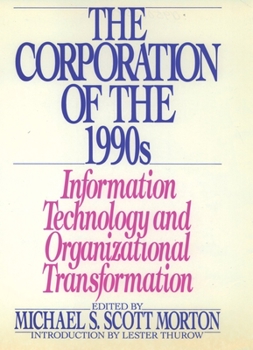The Corporation of the 1990s: Information Technology and Organizational Transformation
Select Format
Select Condition 
Book Overview
Since the invention of the telegraph, information technology (IT) has revolutionized the way we communicate, the way we do business, and the way we live. From the telephone to the fax machine, the Hollerith tabulating machine to the modern-day computer, IT has collapsed time and distance, becoming indispensable in today's world economy. And yet, though businesses and organizations have spent tremendous amounts of money on computer hardware and software, these investments in IT have not raised most organizations' productivity or profitability. How can organizations make better use of the available technology?
The Corporation of the 1990s presents an expert view of how information technology will influence organizations and their ability to survive and prosper in this decade and beyond. Featuring a foreword by Lester C. Thurow, Dean of MIT's Sloan School of Management, and an introduction by Michael S. Scott Morton, it represents the fruit of an active collaboration between scholars from MIT's Sloan School and ten major corporations--including American Express, Digital Equipment Corporation, Eastman Kodak, General Motors, British Petroleum, and MCI Communications--and two U.S. governmental agencies.
This highly readable, exhaustively researched volume describes how the rapidly changing global economy has placed new demands on corporations; at the same time, the contributors point to the exponential growth of IT in recent years--from electronic check-out counters at grocery stores to ATMs on street corners to the widespread use of electronic mail--discussing how this tremendous IT resource can be used to master the changing market. The authors also present a wealth of real-life examples of organizations that have used IT effectively and profitably. The IRS, for instance, now provides an electronic filing system for individual taxpayers. And airlines, realizing that they could solve overbooking problems by offering customers various package deals (such as free flights and cash) in exchange for their reserved seats, have developed sophisticated computer systems which allow them to play more boldly with the probabilities of flight capacity.
The authors argue that corporations will not survive just by working harder and faster within existing organizational structures. Instead, organizations will have to restructure, invest heavily in human resources, and adopt totally new concepts of managing. Only then will they be able to create new strategies that will allow them to get closer to customers' real needs--and only then will their investments in IT pay off.
The Corporation of the 1990s presents an expert view of how information technology will influence organizations and their ability to survive and prosper in this decade and beyond. Featuring a foreword by Lester C. Thurow, Dean of MIT's Sloan School of Management, and an introduction by Michael S. Scott Morton, it represents the fruit of an active collaboration between scholars from MIT's Sloan School and ten major corporations--including American Express, Digital Equipment Corporation, Eastman Kodak, General Motors, British Petroleum, and MCI Communications--and two U.S. governmental agencies.
This highly readable, exhaustively researched volume describes how the rapidly changing global economy has placed new demands on corporations; at the same time, the contributors point to the exponential growth of IT in recent years--from electronic check-out counters at grocery stores to ATMs on street corners to the widespread use of electronic mail--discussing how this tremendous IT resource can be used to master the changing market. The authors also present a wealth of real-life examples of organizations that have used IT effectively and profitably. The IRS, for instance, now provides an electronic filing system for individual taxpayers. And airlines, realizing that they could solve overbooking problems by offering customers various package deals (such as free flights and cash) in exchange for their reserved seats, have developed sophisticated computer systems which allow them to play more boldly with the probabilities of flight capacity.
The authors argue that corporations will not survive just by working harder and faster within existing organizational structures. Instead, organizations will have to restructure, invest heavily in human resources, and adopt totally new concepts of managing. Only then will they be able to create new strategies that will allow them to get closer to customers' real needs--and only then will their investments in IT pay off.
Format:Hardcover
Language:English
ISBN:0195063589
ISBN13:9780195063585
Release Date:February 1991
Publisher:Oxford University Press
Length:352 Pages
Weight:1.50 lbs.
Dimensions:1.2" x 6.4" x 9.5"
Customer Reviews
2 ratings
The Corporation of the 1990s: Information Technology and Organizational Transformation
Published by Thriftbooks.com User , 16 years ago
Perfect for students reading any course that looks at organizations and the use of IT to bring about business benefits.
Beyond the 90s
Published by Thriftbooks.com User , 25 years ago
This book nicley discussed like what will be the management focus, tactics and techniques of progressive business in the 90s and beyond? How will these organisations adapt to their chaning environments and develop new directions and strategies? How will management develop these new techniques and skills to make their organisations progressive in an environment in which IT is changing rapidly.It is a good book for executives with flair for IT.






